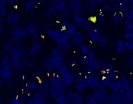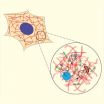(Press-News.org) Whether pneumonia or sepsis – infectious diseases are becoming increasingly difficult to treat. One reason for this is the growing antibiotic resistance. But even non-resistant bacteria can survive antibiotics for some time, and that's why treatments need to be continued for several days or weeks. Scientists at the Biozentrum of the University of Basel showed that bacteria with vastly different antibiotic sensitivity coexist within the same tissue. In the scientific journal Cell they report that, in particular, slowly growing pathogens hamper treatment.
Many bacteria are principally susceptible to treatment, but can still survive for some hours to days in adverse environmental conditions, such as exposure to antibiotics. It is commonly assumed that these pathogens are in a type of "dormancy" state. They don't grow and thus become invulnerable against the effects of many antibiotics. However, Prof. Dirk Bumann and his team at the University of Basel's Biozentrum, demonstrated that dormant pathogens play only a minor role in Salmonella-infected tissue. Instead, abundant slowly growing bacteria are the biggest challenge for treatment.
Salmonella Grows at Different Rates
Genetically identical bacteria can grow at very different rates, even within the same test tube. Is this also true for pathogens in infected host tissues? Bumann used a new method based on fluorescent colors, to measure the proliferation of individual Salmonella. The results revealed that in host tissues some Salmonella grow very rapidly, producing many daughter cells, which cause increasingly severe disease. Most bacteria, however, reside in tissue regions with limited nutrient supply, in which they grow only slowly.
Slow Growth Ensures Survival
How do these diverse growth rates impact on the success of antibiotic therapy? Therapy of infected mice quickly ameliorated disease signs, but even after five days of treatment, some bacteria still survived in the tissues, posing a risk for relapse. "We could kill already 90 percent of the Salmonella with the first antibiotic dose, particularly those that grew rapidly", reports Bumann, "but non-growing Salmonella survived much better. Treatment success thus depended on the Salmonella replication rate."
This observation could support the current research focus on "dormant" bacteria. However, Bumann was surprised that such bacteria were actually not the biggest challenge for treatment. "Instead, slowly growing Salmonella are more important. They tolerate antibiotics less well compared to dormant bacteria, but they are present in much larger numbers, and readily restart their growth once antibiotic levels in the tissue drop, thus driving infection and relapse. As a result, slowly growing pathogens dominate throughout the entire therapy. A better understanding of bacterial physiology of such slowly growing bacteria, could help us to shorten the duration of treatment with a more specifically targeted antibiotic therapy." This is particularly interesting for infectious diseases that currently require medication over several weeks or even months, to prevent a recurrence of the infection.
INFORMATION:
Original Source
Beatrice Claudi, Petra Spröte, Anna Chirkova, Nicolas Personnic, Janine Zankl, Nura Schürmann, Alexander Schmidt, and Dirk Bumann
Phenotypic variation of Salmonella in host tissue delays eradication by antibiotic chemotherapy
Cell, published 14 August 2014
Long antibiotic treatments: Slowly growing bacteria to blame
2014-08-14
ELSE PRESS RELEASES FROM THIS DATE:
Tissue development 'roadmap' created to guide stem cell medicine
2014-08-14
In a boon to stem cell research and regenerative medicine, scientists at Boston Children's Hospital, the Wyss Institute for Biologically Inspired Engineering at Harvard University and Boston University have created a computer algorithm called CellNet as a "roadmap" for cell and tissue engineering, to ensure that cells engineered in the lab have the same favorable properties as cells in our own bodies. CellNet and its application to stem cell engineering are described in two back-to-back papers in the August 14 issue of the journal Cell.
Scientists around the world are ...
Antibodies, together with viral 'inducers,' found to control HIV in mice
2014-08-14
Although HIV can now be effectively suppressed using anti-retroviral drugs, it still comes surging back the moment the flow of drugs is stopped. Latent reservoirs of HIV-infected cells, invisible to the body's immune system and unreachable by pharmaceuticals, ensure that the infection will rebound after therapy is terminated.
But a new strategy devised by researchers at Rockefeller University harnesses the power of broadly neutralizing antibodies against HIV, along with a combination of compounds that induce viral transcription, in order to attack these latent reservoirs ...
Researchers identify a mechanism that stops progression of abnormal cells into cancer
2014-08-14
(Boston)-- Researchers from Boston University School of Medicine (BUSM) report that a tumor suppressor pathway, called the Hippo pathway, is responsible for sensing abnormal chromosome numbers in cells and triggering cell cycle arrest, thus preventing progression into cancer.
Although the link between abnormal cells and tumor suppressor pathways—like that mediated by the well known p53 gene—has been firmly established, the critical steps in between are not well understood. According to the authors, whose work appears in Cell, this work completes at least one of the ...
Researchers develop strategy to combat genetic ALS, FTD
2014-08-14
JACKSONVILLE, Fla. — A team of researchers at Mayo Clinic and The Scripps Research Institute in Florida have developed a new therapeutic strategy to combat the most common genetic risk factor for the neurodegenerative disorders amyotrophic lateral sclerosis (ALS or Lou Gehrig's disease) and frontotemporal dementia (FTD). In the Aug. 14 issue of Neuron, they also report discovery of a potential biomarker to track disease progression and the efficacy of therapies.
The scientists developed a small-molecule drug compound to prevent abnormal cellular processes caused by a ...
Inside the cell, an ocean of buffeting waves
2014-08-14
Cambridge, Mass. – August 14, 2014 – Conventional wisdom holds that the cytoplasm of mammalian cells is a viscous fluid, with organelles and proteins suspended within it, jiggling against one another and drifting at random. However, a new biophysical study led by researchers at Harvard University challenges this model and reveals that those drifting objects are subject to a very different type of environment.
The cytoplasm is actually an elastic gel, it turns out, so it puts up some resistance to simple diffusion. But energetic processes elsewhere in the cell—in the cytoskeleton, ...
Forcing chromosomes into loops may switch off sickle cell disease
2014-08-14
Scientists have altered key biological events in red blood cells, causing the cells to produce a form of hemoglobin normally absent after the newborn period. Because this hemoglobin is not affected by the inherited gene mutation that causes sickle cell disease, the cell culture findings may give rise to a new therapy for the debilitating blood disorder.
The novel approach uses protein-engineering techniques to force chromatin fiber, the substance of chromosomes, into looped structures that contact DNA at specific sites to preferentially activate genes that regulate hemoglobin. ...
NASA sees Tropical Storm Julio now far from Hawaii
2014-08-14
Hurricane Julio moved past the Hawaiian Islands like a car on a highway in the distance, and NASA's Terra satellite captured an image of the storm, now downgraded to a tropical storm located more than 700 miles away. Julio is far enough away from Hawaii so that there are no coastal watches or warnings in effect.
On August 13 at 21:10 UTC (5:10 p.m. EDT), the Moderate Resolution Imaging Spectroradiometer of MODIS instrument aboard NASA's Terra satellite captured a visible image of Hurricane Julio moving through the Central Pacific Ocean. The visible image shows that powerful ...
EARTH Magazine: Are slow-slip earthquakes under Tokyo stressing faults?
2014-08-14
Alexandria, Va. — Tokyo, a city of more than 13 million people, has been devastated by earthquakes in the past and likely will be again. But when? And what role do ongoing slow-slip earthquakes — the kind that generally can't be felt at the surface — play in relieving or building up stress?
New research examining plate movements under Tokyo has found that since the massive magnitude-9 Tohoku earthquake and tsunami in March 2011, recurrence intervals for nondamaging slow-slip quakes beneath Japan's capital have shortened. That has left seismologists wondering if this aseismic ...
A husband's declining health could put Taiwanese women at risk for health issues
2014-08-14
PRINCETON, N.J.—The death of a spouse undoubtedly brings with it stress, anxiety and uncertainty. Now, a report by Princeton University's Woodrow Wilson School of Public and International Affairs quantifies this stress, showing how a husband's declining health could put Taiwanese women at risk for health issues.
Using data from a longitudinal sample of Taiwanese older adults, the researchers found that the more a husband suffered, the more his wife's glucose levels increased. Yet, when a wife's health was declining, her husband's levels remained the same. Being widowed, ...
High prevalence of opioid use by Social Security disability recipients, reports Medical Care
2014-08-14
August 14, 2014 – More than 40 percent of Social Security Disability Insurance (SSDI) recipients take opioid pain relievers, while the prevalence of chronic opioid use is over 20 percent and rising, reports a study in the September issue of Medical Care. The journal is published by Lippincott Williams & Wilkins, a part of Wolters Kluwer Health.
The high proportion of SSDI recipients who are chronic opioid users—in many, at high and very high daily doses—"is worrisome in light of established and growing evidence that intense opioid use to treat non-malignant [non-cancer] ...


